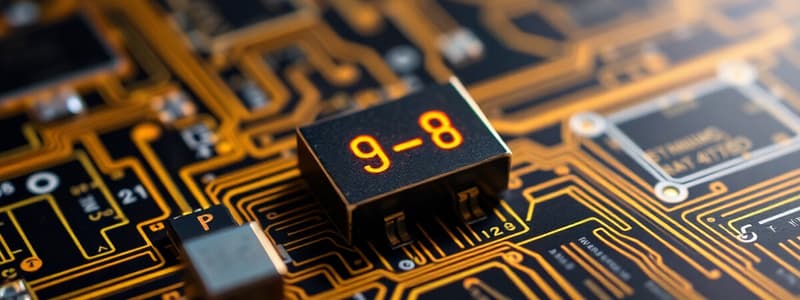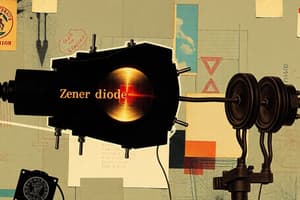Podcast
Questions and Answers
What does 𝑟𝑎𝑣 represent in the context of average AC resistance?
What does 𝑟𝑎𝑣 represent in the context of average AC resistance?
- The average of AC values from 2 mA to 17 mA (correct)
- The resistance during dynamic operation only
- A fixed value independent of current levels
- The total resistance of the circuit under all conditions
What does the piecewise-linear equivalent circuit of a diode primarily focus on?
What does the piecewise-linear equivalent circuit of a diode primarily focus on?
- Ignoring voltage levels during analysis
- Approximating diode characteristics with straight-line segments (correct)
- Minimizing all components to a single ideal resistor
- Establishing multiple directions of conduction
What happens to 𝑟𝑎𝑣 in the simplified equivalent circuit for most applications?
What happens to 𝑟𝑎𝑣 in the simplified equivalent circuit for most applications?
- It becomes the dominant resistance in the circuit
- It shifts the conduction direction of the diode
- It is removed and ignored in comparison to other elements (correct)
- It is doubled to match AC dynamics
What role does the battery 𝑉𝐾 play in the piecewise-linear equivalent circuit?
What role does the battery 𝑉𝐾 play in the piecewise-linear equivalent circuit?
What can be implied by removing 𝑟𝑎𝑣 from the ideal equivalent circuit?
What can be implied by removing 𝑟𝑎𝑣 from the ideal equivalent circuit?
What is the average voltage across a Ge diode at a current of 1 mA?
What is the average voltage across a Ge diode at a current of 1 mA?
At a current of 30 mA, what is the voltage across the Si diode?
At a current of 30 mA, what is the voltage across the Si diode?
Which type of resistance is characterized by a stable operating point when a DC voltage is applied to a diode?
Which type of resistance is characterized by a stable operating point when a DC voltage is applied to a diode?
How is the dynamic resistance of a diode generally defined under sinusoidal voltage conditions?
How is the dynamic resistance of a diode generally defined under sinusoidal voltage conditions?
What is the average value of the voltage across a GaAs diode at a current of 4 mA?
What is the average value of the voltage across a GaAs diode at a current of 4 mA?
What does the average AC resistance reflect in a diode's operation?
What does the average AC resistance reflect in a diode's operation?
In the comparison of Ge, Si, and GaAs diodes, which diode exhibits the highest voltage at a current of 30 mA?
In the comparison of Ge, Si, and GaAs diodes, which diode exhibits the highest voltage at a current of 30 mA?
Which diode has an average voltage value closest to its knee voltage at 1 mA?
Which diode has an average voltage value closest to its knee voltage at 1 mA?
Flashcards
Diode Characteristics
Diode Characteristics
The relationship between voltage and current in a diode, displayed graphically.
Static Resistance
Static Resistance
The resistance of a diode at a fixed operating point.
Dynamic Resistance
Dynamic Resistance
The resistance of a diode when the operating point changes, like with a varying input signal.
Average AC Resistance
Average AC Resistance
Signup and view all the flashcards
Ge Diode Voltage
Ge Diode Voltage
Signup and view all the flashcards
Si Diode Voltage
Si Diode Voltage
Signup and view all the flashcards
GaAs Diode Voltage
GaAs Diode Voltage
Signup and view all the flashcards
Nonlinear Characteristics
Nonlinear Characteristics
Signup and view all the flashcards
Average AC Resistance
Average AC Resistance
Signup and view all the flashcards
Equivalent Circuit
Equivalent Circuit
Signup and view all the flashcards
Piecewise-Linear Equivalent Circuit
Piecewise-Linear Equivalent Circuit
Signup and view all the flashcards
Simplified Equivalent Circuit
Simplified Equivalent Circuit
Signup and view all the flashcards
Ideal Equivalent Circuit
Ideal Equivalent Circuit
Signup and view all the flashcards
Study Notes
Fundamentals of Electronics
- The presentation covers the fundamentals of electronics, specifically diode characteristics and circuits.
- It introduces Shockley's equation, which defines the general characteristics of semiconductor diodes.
- The equation is: ID = Is(eVD/nVT – 1)
- Variables include: ID (diode current), Is (reverse saturation current), VD (forward bias voltage), n (ideality factor), VT (thermal voltage).
- The thermal voltage VT is calculated as VT = KT / q
- Boltzmann's constant (k) = 1.38 × 10⁻²³ J/K
- Absolute temperature (TK) is calculated as 273 + °C
- Magnitude of electronic charge (q) = 1.6 × 10⁻¹⁹ C
Diode Characteristics and Circuits
- Diode characteristics are defined by Shockley's equation.
- The ideality factor (n) typically ranges from 1 to 2, with 1 being a common assumption.
- Diode current changes based on the applied voltage (forward or reverse bias).
- For positive VD values, ID = Is e^(VD/nVT)
- For negative VD values, ID = -Is
Resistance Levels
- Diode resistance changes as the operating point moves between regions.
- There are three types of resistance: DC or Static Resistance, AC or Dynamic Resistance, and Average AC Resistance.
Diode Equivalent Circuits
-
Equivalent circuits represent the diode's terminal characteristics.
-
Three types of equivalent circuits are included:
- Piecewise-linear Equivalent Circuit
- Simplified Equivalent Circuit
- Ideal Equivalent Circuit
-
The Piecewise-linear circuit approximates the diode's characteristics using straight-line segments.
-
The Simplified circuit removes the average resistance and considers only the diode's voltage drop.
-
The Ideal circuit only allows current in one direction. The voltage drop is zero in the forward direction and infinite in the reverse direction.
-
The presentation also includes practical examples demonstrating how to calculate current and voltage using each model.
Studying That Suits You
Use AI to generate personalized quizzes and flashcards to suit your learning preferences.




